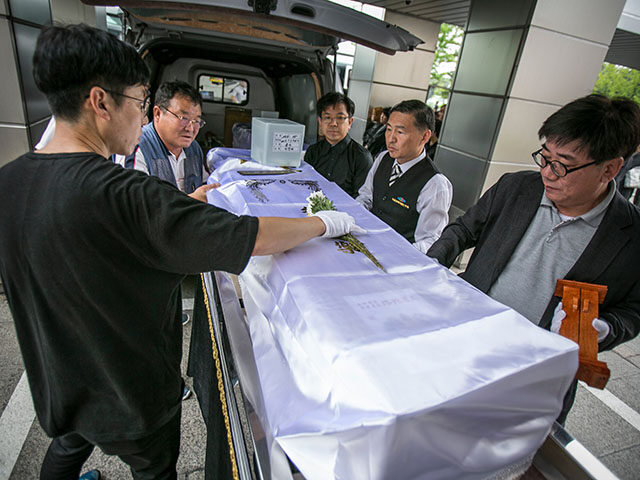South Korea’s demographic crisis is driven by the world’s lowest fertility rates, but there are problems on the other end of the life cycle as well, according to a report on Tuesday.
Korea JoongAng Daily (KJD) reported that South Korean families must “struggle to cremate the dead because of limited crematorium capacity and increasing death tolls of older adults.”
Traditional South Korean funerals usually last for three days after a person dies, but the crematorium shortage is so severe that only about 64 percent of the deceased can be cremated on the usual third day, prolonging many funerals to four days or more.
The crematorium shortage is especially acute in big cities such as Seoul, where only 33.6 percent of bodies were cremated on the third day. KJD checked and discovered some big-city crematoriums are currently booked solid through Saturday, so someone who passed away today would have to wait until Sunday or later.
The backlog is so severe that many families “make crematorial reservations even before the doctor pronounces death.” The funeral industry is scrambling to extend its operating hours and build more furnaces to handle the demand. Families are reluctantly storing funeral urns in their homes, or even in the cars, after late-evening cremations so the funerals can be completed on the following day.
KJD noted some of the usual infrastructure quibbles are preventing South Korean cities from building enough crematories – limited and expensive real estate, residents do not want crematories built in their backyards – but the biggest and most intractable problem is a demographically collapsing society struggling to deal with a rising tide of surplus death:
Considering demographic and time-related factors, the supply and demand for crematories do not match perfectly.
Once Korea becomes a super-aged society — when more than 20 percent of the total population is over 65 — and the death toll surges, the crematorium shortage will likely grow out of control.
Statistics Korea predicted that the annual death toll will reach 410,000 in the 2030s, beyond the current cremation capacity.
The current national death toll seems to be well within South Korea’s national cremation capacity – about 346,000 annual cremation slots are available, compared to 342,000 deaths – but demand far outstrips supply in big cities with tough zoning laws. When total deaths actually exceed nominal capacity nationwide, the cities will be in very rough shape.
The crematorium shortage first became uncomfortably apparent in 2020, just before the Wuhan coronavirus pandemic struck, and funeral experts warned the country was not building new facilities fast enough to keep pace with demand. At the time, the massive cities of Incheon and Busan only had one crematory apiece. Shipping the deceased to less overbooked rural facilities is very expensive, increasing the cost of funerals by 500 percent or more.
Besides calling for more aggressive crematorium construction and looser zoning laws, funeral industry sources could only suggest relenting on traditional three-day funerals for more “flexible funeral practices,” as funeral expert Park Tae-ho put it.
This could be a tough sell for tradition-minded South Koreans, whose extended funeral rites are meant as upbeat family gatherings and celebrations of life, as well as fond farewells to the departed. The massive shift to cremation was already a compromise with the reality that cemetery burials were simply too expensive.
Channel News Asia (CNA) reported in April that shifting demographics are causing more childless, unmarried young and middle-aged South Koreans to plan for simple, utilitarian funerals instead of elaborate three-day family ceremonies.
In Korean culture, a “lonely death” or kodoksa is considered a mournful fate, bordering on horrifying. South Korean men are statistically about five times as likely to die alone as women, especially when they die relatively young from illness or suicide, or live below the poverty line.
An increasing number of isolated men are dying alone, their bodies left undiscovered for days. Prodded by the increase in such deaths, South Korea passed a law in 2021 called the Lonely Death Prevention and Management Act, a measure the legislature felt was necessary “preparation for a super-aged society.”
“Over the past five years, the number of lonely deaths has grown at an average annual rate of about 8.8 percent,” CNA observed. Over 30 percent of the South Korean population is now single.
These demographic trends have prompted more South Koreans to plan their own funerals since they lack children to handle that traditional duty. The funeral industry is adjusting its sales pitches to reach the growing population of lifelong singles and has urged the government to design policies for a future where the demand for cremation grows increasingly pronounced, while fewer young people are available to build and work the furnaces.

COMMENTS
Please let us know if you're having issues with commenting.